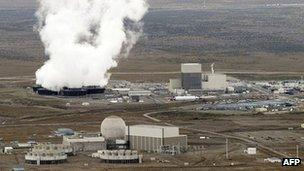Washington State nuclear waste tanks 'leaking'
- Published

Six underground storage tanks at a nuclear site in the US state of Washington are leaking, authorities say.
Governor Jay Inslee described the situation at the Hanford Nuclear Reservation as "disturbing news".
But he stressed that there was no current risk to human health.
Nearly 200 ageing containers hold millions of litres of radioactive waste left from decades of plutonium production for nuclear weapons.
"There is no immediate or near-term health risk associated with these newly discovered leaks, which are more than five miles (8km) from the Columbia River," Mr Inslee said in a statement.
"But nonetheless this is disturbing news for all Washingtonians," he added.
Last week, a leak was reported in one of the storage tanks. Officials said it was leaking at a rate of up 300 gallons (1,136 litres) per year.
They said that tests had not detected higher radiation levels near the tanks.
Established as part of the Manhattan Project in 1943, Hanford was home to the world's first full-scale plutonium production facility.
It was part of America's bid to build the world's first nuclear weapon during World War II.
The site produced the plutonium for the bomb that was dropped on the Japanese city of Nagasaki. Production at Hanford continued until 1989.
Under a costly clean-up proposal, the waste will eventually be treated in a special plant. It will then be safely disposed of underground in stainless steel canisters.